
When you’re planning your fall garden, acorn squash is a wonderful choice! This tasty vegetable is great because it grows well in many different places and tastes delicious. To grow the best acorn squash, remember to choose the right types for your area and prepare your soil properly.
You can also plant other friendly plants nearby to help your squash grow and keep bugs away. So, if you want to grow acorn squash this fall, let’s discover the best ways to make your garden look nice and taste great!
—
Are you ready to plant acorn squash in your fall garden? This tasty vegetable is not just delicious but also easy to grow in many different climates. By preparing the soil and picking the right variety, you can have a bountiful harvest!
Plus, planting helpful companion plants can support your squash and protect it from pests. Let’s dive into the best tips for growing acorn squash and how to make your garden both beautiful and yummy!
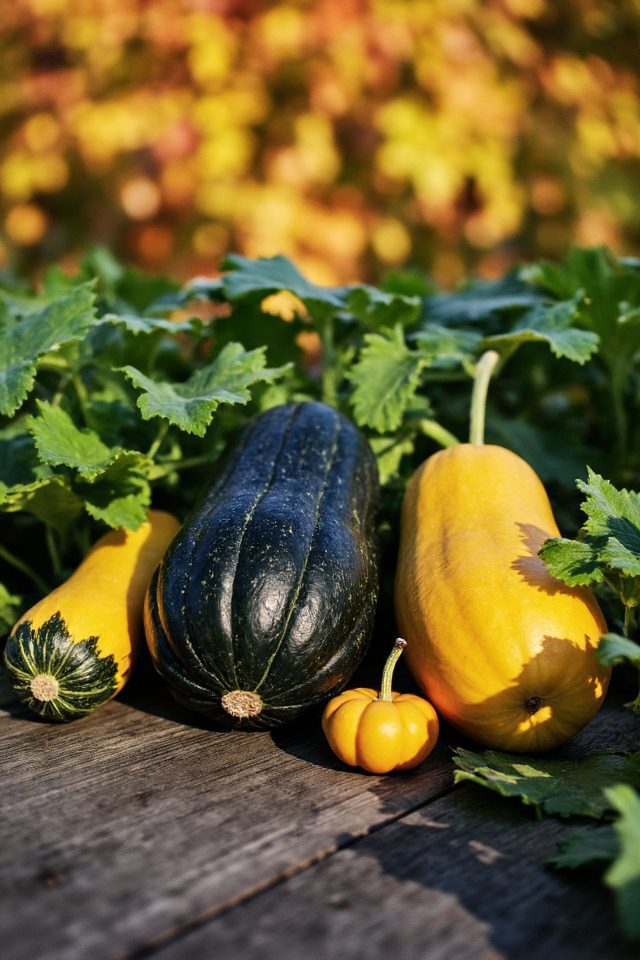
When selecting the right variety of acorn squash for your garden, consider factors such as size, color, and flavor.
Common varieties include the standard green acorn, which has a sweet, nutty taste, and the golden acorn, known for its striking yellow color and slightly sweeter flesh.
Additionally, look for types that are well-suited to your climate and growing conditions, ensuring a healthier, more productive harvest.
Choose varieties that meet your culinary needs for the best results in the kitchen.
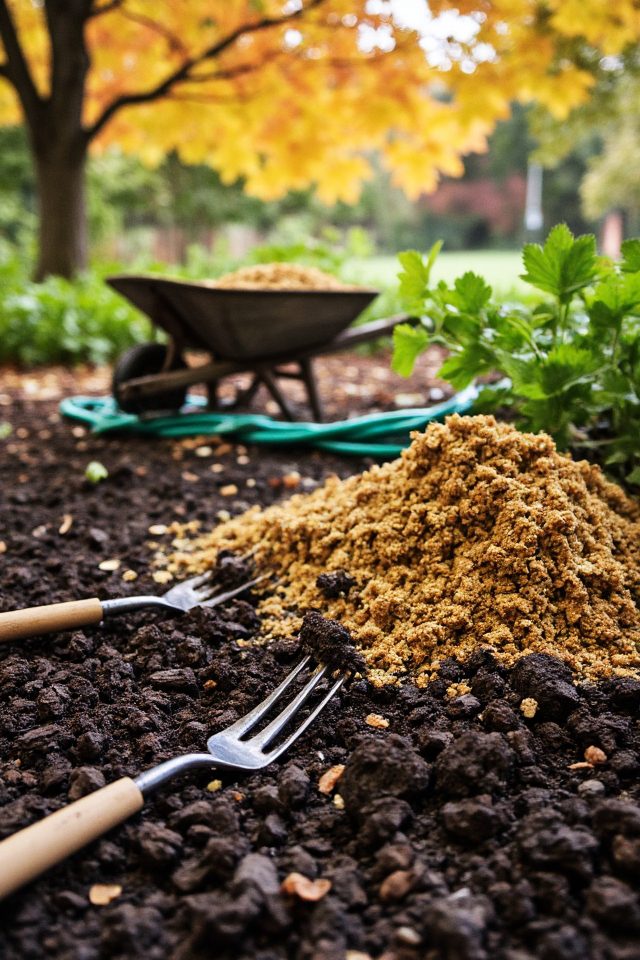
Preparing your garden soil for planting acorn squash is essential for a healthy and bountiful harvest.
Begin by clearing any weeds or debris from the area, then loosen the soil to a depth of at least 12 inches. Incorporate organic matter, such as well-rotted compost or manure, to enhance soil fertility and improve drainage.
Make sure the soil pH is between 6.0 and 7.0, adjusting as necessary, to create ideal conditions for your acorn squash to thrive.
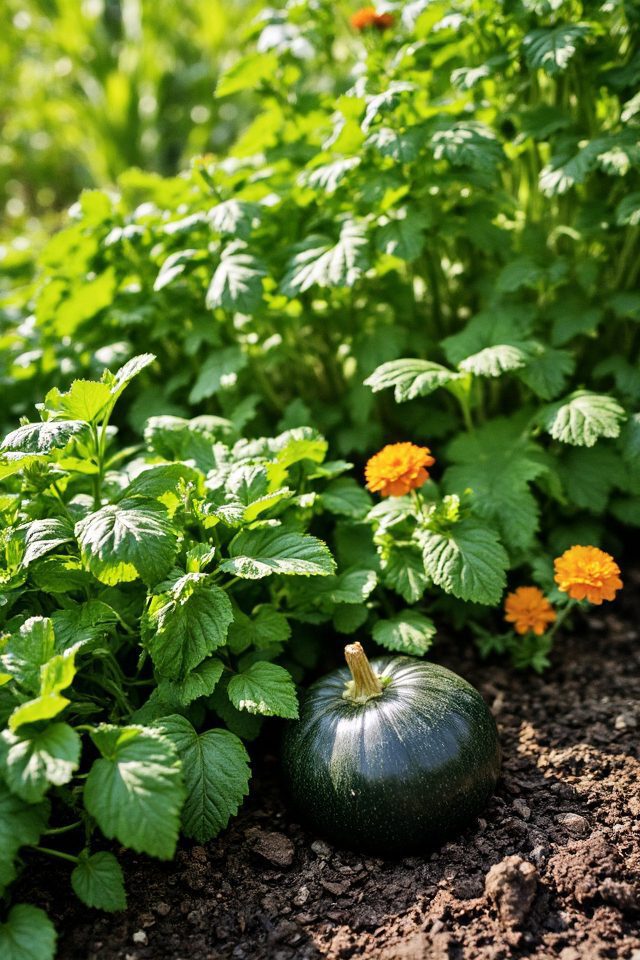
Companion planting can greatly enhance the growth and health of acorn squash by providing beneficial relationships between plants.
Ideal companions include beans, which enrich the soil with nitrogen, and corn, which offers support to the sprawling squash vines.
Additionally, planting herbs like basil and marigold not only deter pests but also attract pollinators, leading to better fruit development.
This harmonious planting strategy fosters a vibrant garden ecosystem, promoting thriving acorn squash harvests.
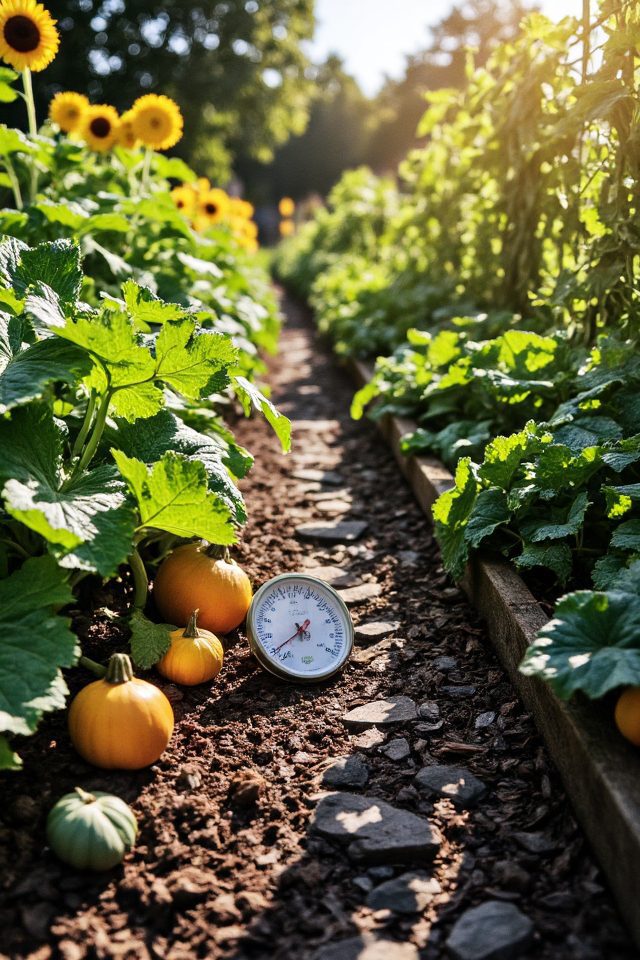
Acorn squash thrives in warm, well-drained soil with a pH between 6.0 and 7.5.
It requires full sun exposure, ideally 6 to 8 hours daily, to promote vigorous growth and sweet flavor.
The ideal planting time is after the last frost when the soil temperature reaches at least 60°F.
Adequate spacing between plants (2 to 3 feet apart) allows for proper air circulation, reducing the risk of disease and ensuring healthy crops.
Regular watering, especially during dry spells, is essential for ideal fruit development.
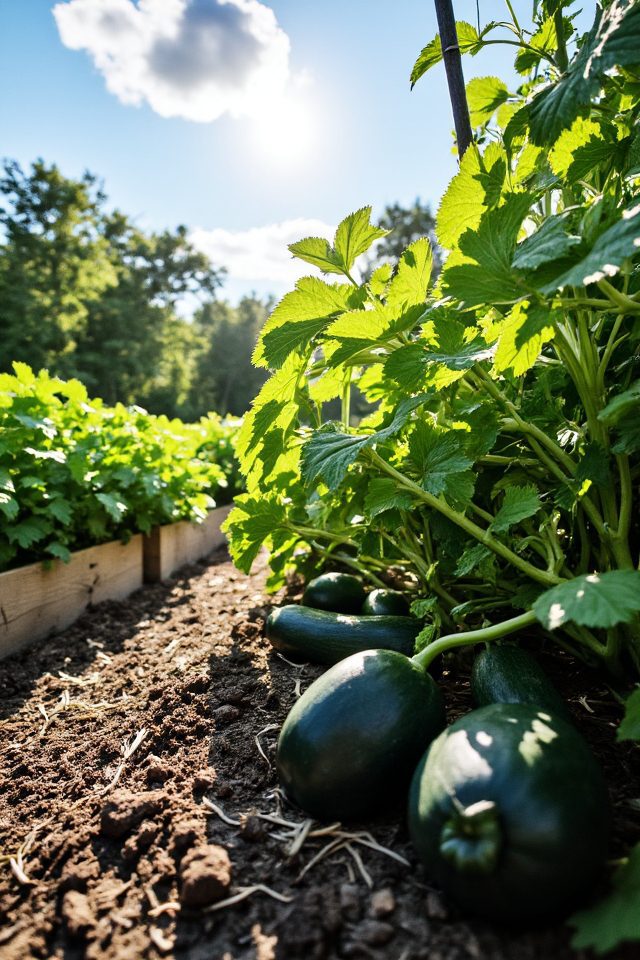
Utilizing raised beds for growing acorn squash can greatly enhance drainage and improve overall plant health. The elevated structure allows excess water to drain away from the roots, reducing the risk of rot and disease.
Raised beds also warm up faster in the spring, promoting earlier growth. Additionally, they provide better control over soil quality and nutrients, ensuring that your acorn squash thrive throughout the growing season.
Incorporating organic matter into the soil will further benefit these delicious gourds.
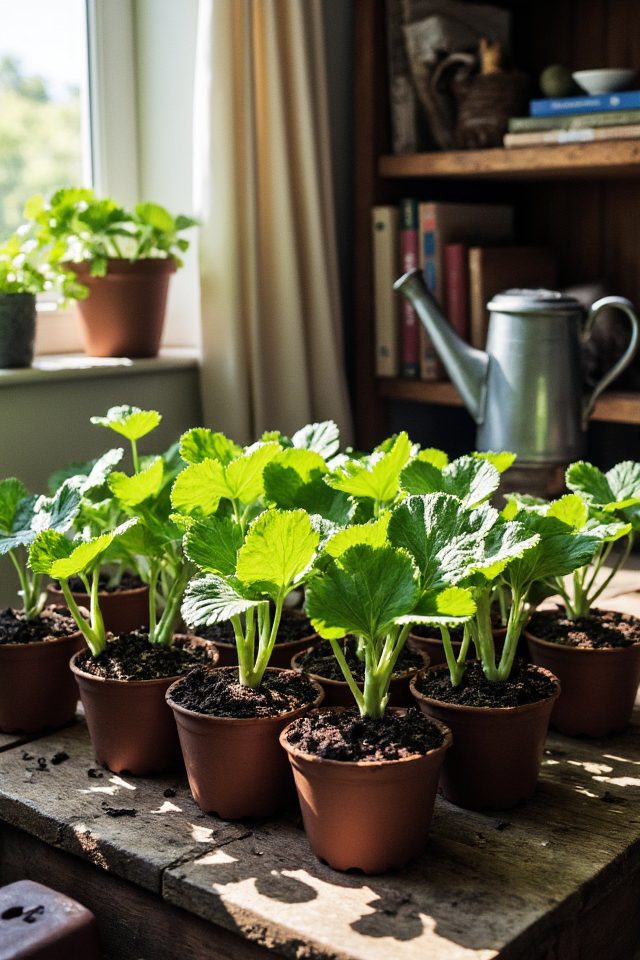
Starting acorn squash seeds indoors can lead to an earlier harvest, as it allows for a jumpstart on the growing season.
Begin by planting seeds in biodegradable pots filled with quality seed starting mix about 4-6 weeks before the last frost date in your area. Keep the soil warm and consistently moist, placing the pots in a sunny location or under grow lights.
Once the seedlings develop a few true leaves and outdoor conditions are favorable, transplant them into your garden for a bountiful yield.
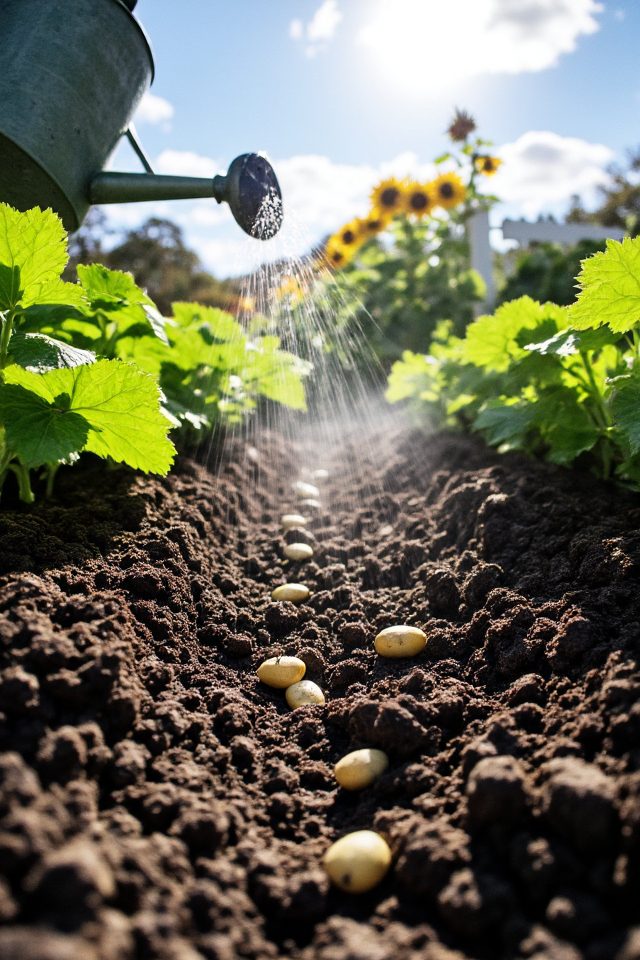
Direct sowing seeds in the garden is an excellent method for cultivating acorn squash.
Choose a sunny location with well-drained soil, and plant seeds approximately 1 inch deep and 3 feet apart to allow for ample growth space.
Water the area gently and consistently, keeping the soil moist but not soggy.
With proper care, seeds will germinate within a week or two, leading to a bountiful harvest of delicious acorn squash in late summer or early fall.

Implementing crop rotation techniques is essential for maintaining the health and productivity of your acorn squash garden.
By alternating the location of your squash plants each growing season, you can prevent soil depletion and reduce the risk of pests and diseases that target specific crops.
Rotate your squash with crops from different families, such as legumes or brassicas, to enhance soil fertility and guarantee ideal growth conditions.
This practice fosters a balanced ecosystem in your garden, promoting healthier plants and yields.
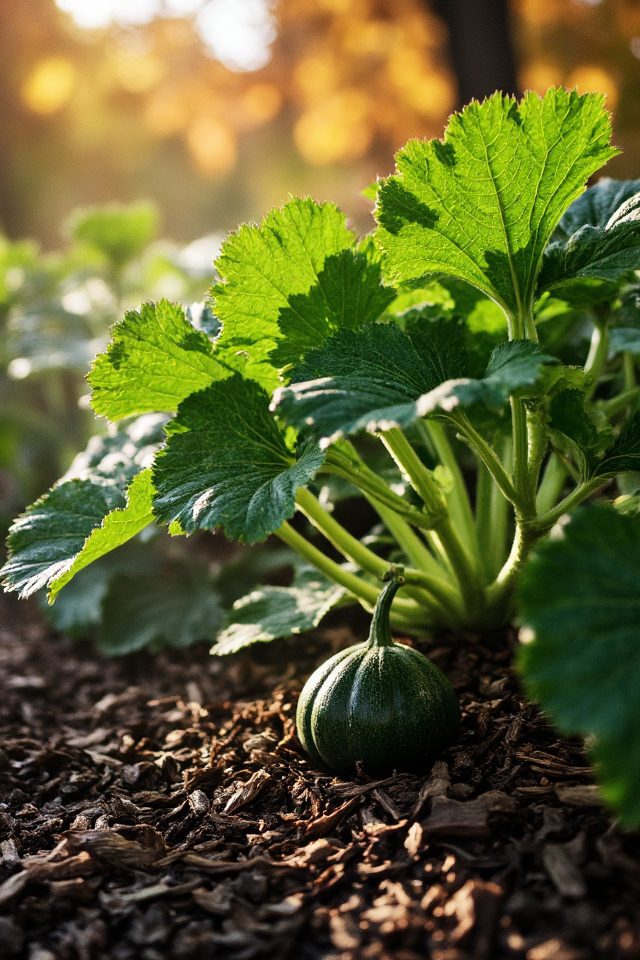
Proper watering is essential for growing healthy acorn squash.
To guarantee peak growth, water the plants deeply once or twice a week, allowing the soil to dry slightly between waterings. Early morning is the best time for watering to reduce evaporation and fungal diseases.
Mulching around the base can help retain moisture and regulate soil temperature, leading to stronger root development and sweeter squash.
Adjust watering based on rainfall and temperature for best results.
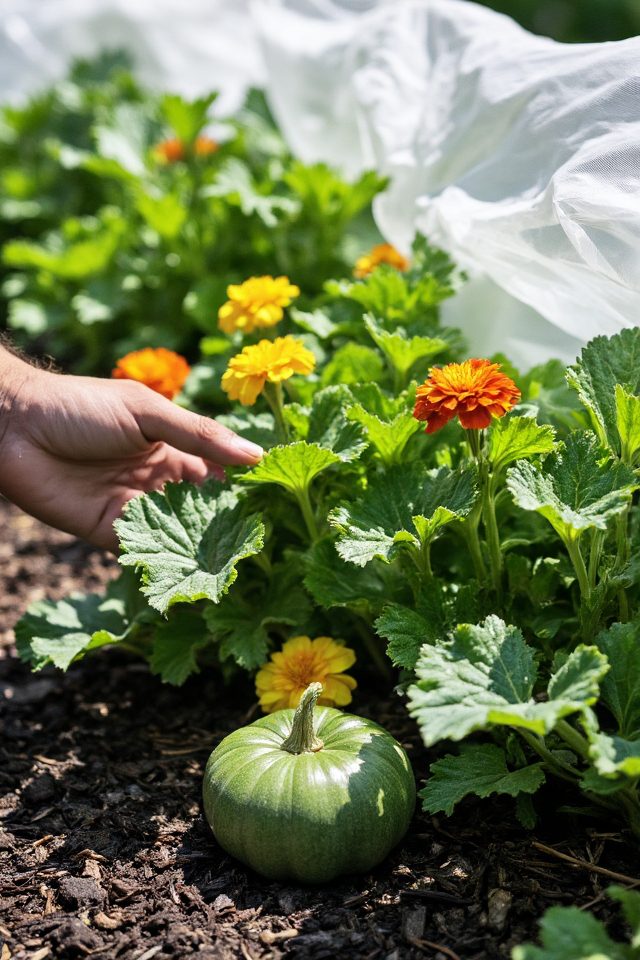
Protecting acorn squash plants from pest infestations is essential for a thriving garden. Implementing companion planting can deter unwanted insects; for example, planting marigolds alongside your squash attracts beneficial predators.
Additionally, using row covers can physically shield your plants from pests while allowing sunlight and moisture to penetrate. Regularly inspect your plants for signs of infestation, and consider using organic insecticidal soap as a treatment if needed.
These strategies will help maintain the health and yield of your acorn squash.
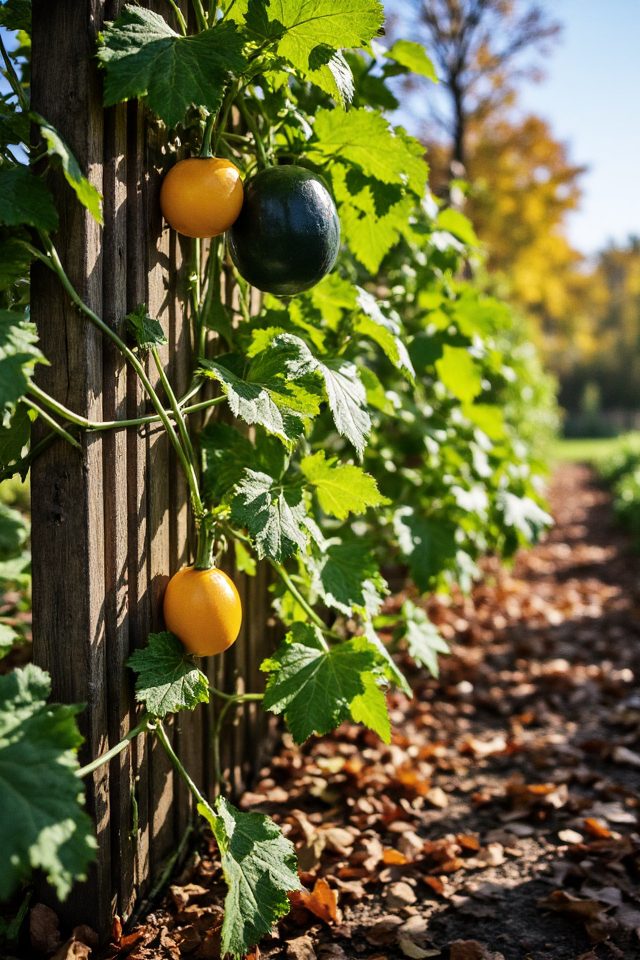
Supporting acorn squash vines with trellises is an effective way to promote healthy growth and maximize space in your garden.
By elevating the vines, you can improve air circulation, reduce the risk of soil-borne diseases, and keep the fruit off the ground, minimizing rot.
Construct a sturdy trellis using wood, wire, or metal, ensuring it can support the weight of the growing squash.
As the plants climb, they can receive ample sunlight, leading to a bountiful harvest.
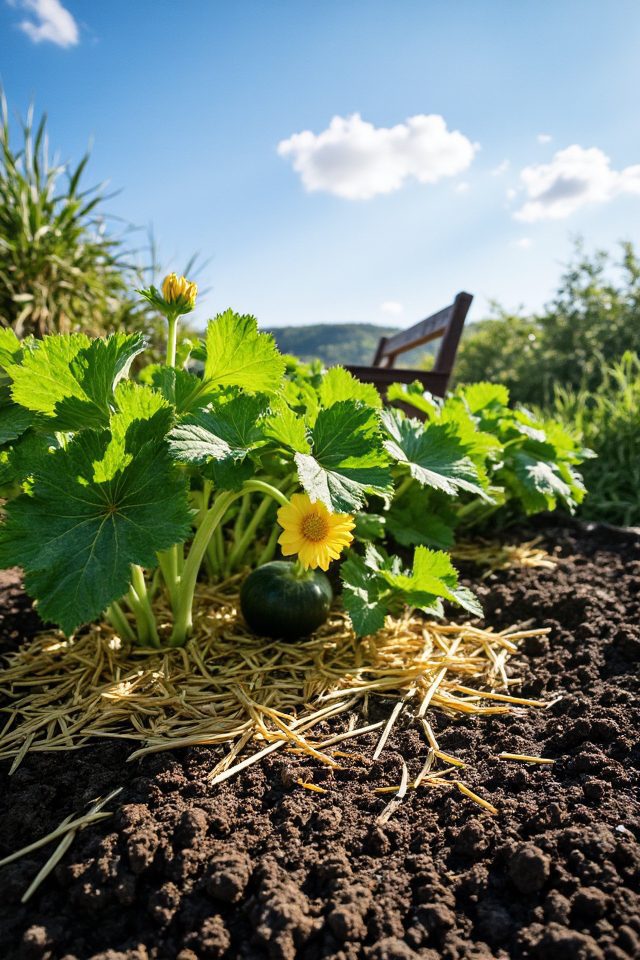
Mulching is an essential practice for growing acorn squash, as it helps retain soil moisture and suppress weed growth.
By applying a layer of organic mulch, such as straw, wood chips, or grass clippings, you create a barrier that protects the soil from evaporation and regulates temperature.
This not only keeps the roots of the acorn squash healthy but also reduces competition from weeds, allowing the plants to thrive and produce a bountiful harvest.
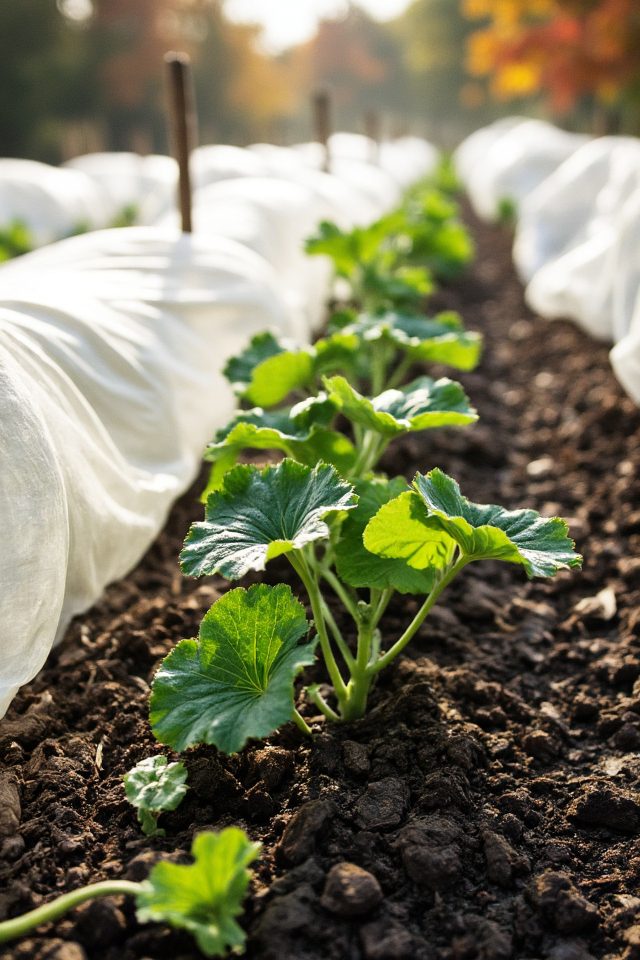
Using row covers for early protection is an effective technique for growing acorn squash in cooler climates.
These lightweight fabric coverings insulate plants, shielding them from frost and providing a warmer microclimate that promotes germination and growth. By placing row covers over seedlings, gardeners can extend the growing season, allowing acorn squash to thrive even in shorter summers.
Additionally, row covers can help deter pests while still allowing sunlight and moisture to penetrate, ensuring healthy plants.
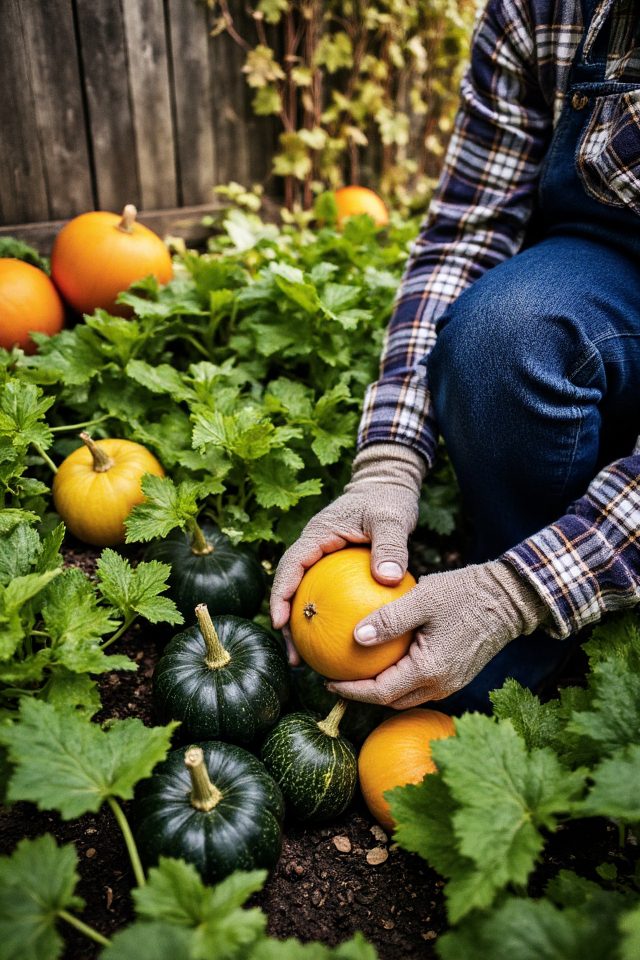
Harvesting acorn squash at the right time is vital for achieving the best flavor and texture.
Typically, acorn squash is ready to be picked when the skin turns a deep green or, in some varieties, a golden yellow, and the stem begins to dry out.
It’s important to gently press on the skin; if it feels hard and resists pressure, it’s ripe.
Harvest before the first frost to guarantee your squash stays sweet and tender.
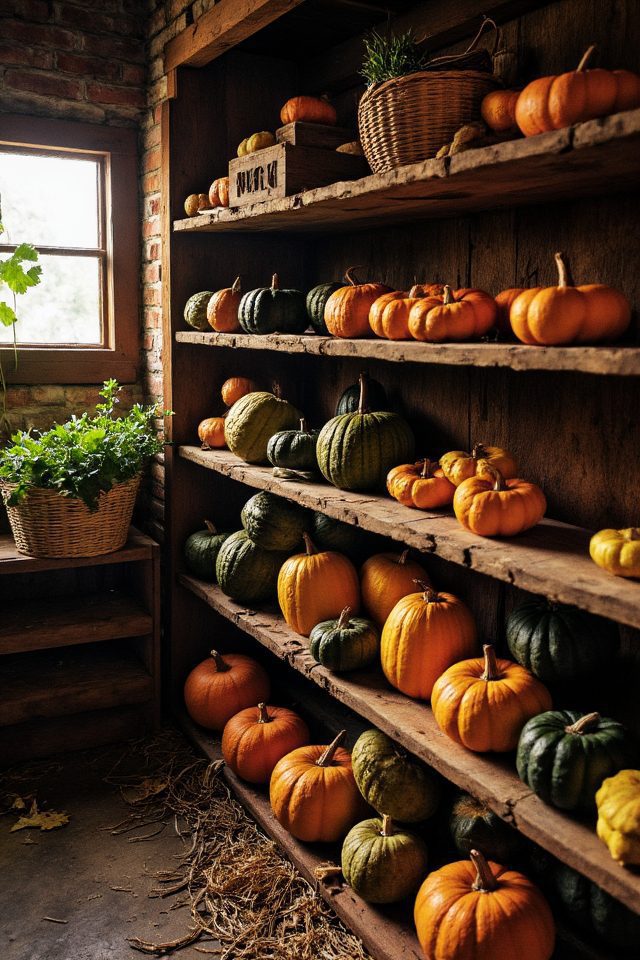
To store acorn squash for longer freshness, begin by selecting undamaged, fully mature squash.
Keep them in a cool, dark place with good ventilation, such as a cellar or pantry, at temperatures between 50-60°F (10-15°C).
Avoid stacking them to prevent bruising and guarantee airflow.
Check them regularly for any signs of spoilage.
When stored properly, acorn squash can last for several weeks to a few months, making it a great option for extended enjoyment.

Acorn squash is a versatile and delicious ingredient that lends itself to a variety of creative recipes. You can roast them with a drizzle of olive oil and spices for a simple side dish, or stuff them with a flavorful mixture of grains, vegetables, and cheese for a hearty main course.
For a sweet twist, try baking acorn squash with brown sugar and cinnamon, allowing the natural sweetness to shine through. The unique shape and rich flavor make acorn squash an excellent choice for any culinary adventure.
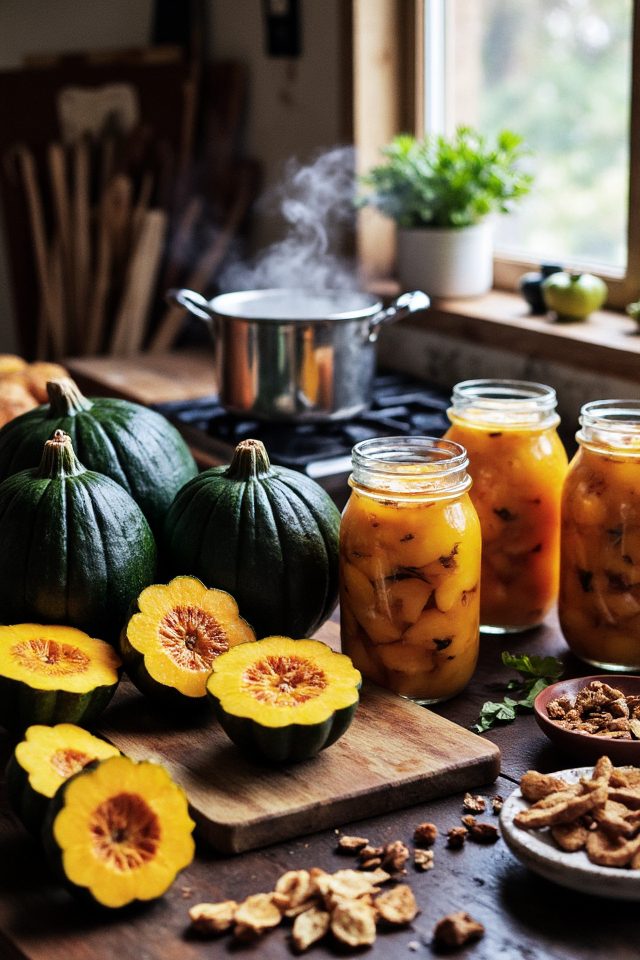
Preserving acorn squash for off-season use is a fantastic way to enjoy its rich flavor and nutritional benefits throughout the year.
One effective method is freezing: first, steam or roast the squash, then scoop out the flesh and store it in airtight containers or freezer bags.
Alternatively, you can also dehydrate slices for long-term storage. Canning is another option, though it requires careful adherence to safety guidelines.
Whichever method you choose, preserving acorn squash allows you to savor its taste beyond the harvest season.

Decorating with harvested acorn squash adds a charming touch to your fall decor.
These unique, ribbed gourds come in rich shades of green, gold, and orange, making them perfect for creating festive centerpieces or accent pieces.
Arrange them in rustic baskets, pair them with seasonal foliage like dried corn stalks or colorful leaves, or use them as part of a themed tablescape.
Their natural beauty and versatility can enhance any autumn celebration or cozy home ambiance.

Teaching kids about gardening with acorn squash can be a fun and engaging experience.
Children can learn about the life cycle of plants as they plant seeds, watch them grow, and eventually harvest the squash. Involving them in hands-on activities, such as watering, weeding, and cooking with the harvested squash, fosters a love for nature and healthy eating.
Gardening also teaches responsibility and patience, making it a valuable educational tool for young minds.
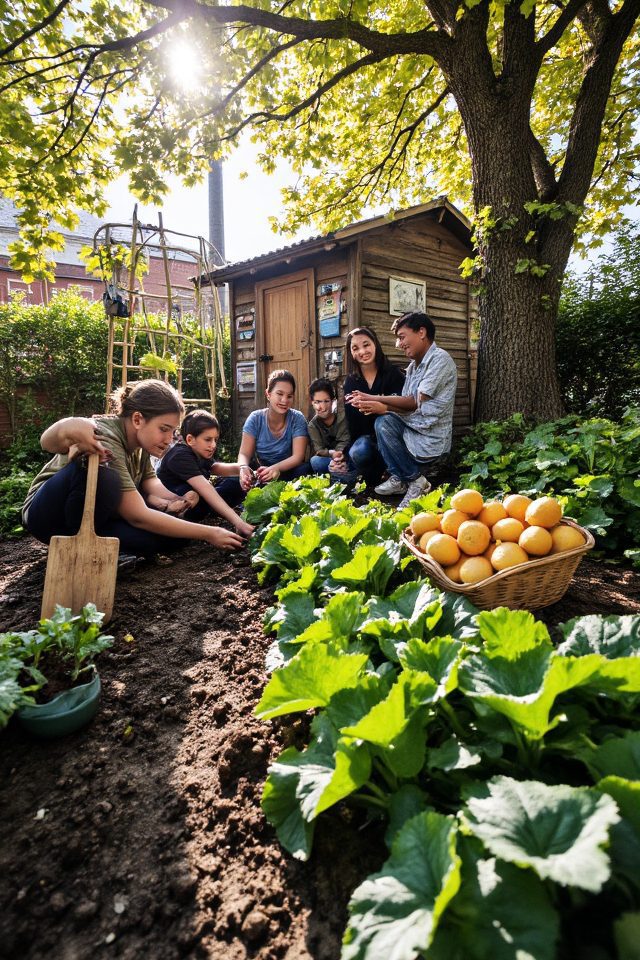
Communal gardening is an excellent way to cultivate acorn squash while fostering community spirit and shared resources. By collaborating with neighbors, you can create a dedicated space for planting, watering, and harvesting these delicious vegetables.
Participants can share tools, knowledge, and labor, ensuring a diverse and bountiful harvest. Additionally, communal gardening encourages social interactions, making it an enjoyable and rewarding experience for everyone involved, as you all reap the benefits of your collective efforts.
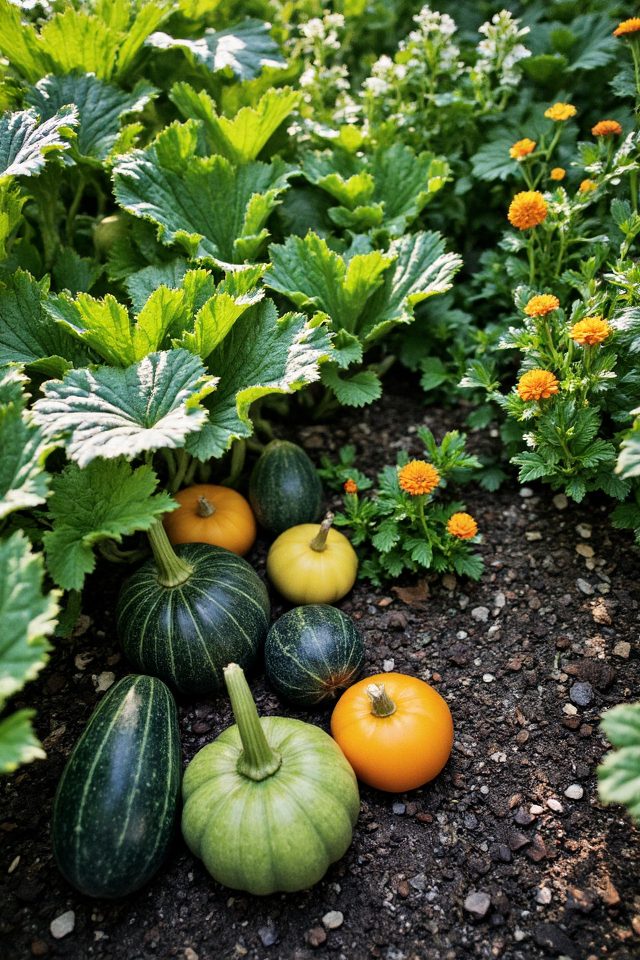
Experimenting with squash varieties in your garden can yield delightful surprises and diverse harvests.
From the sweet, nutty flavor of acorn squash to the vibrant hues of summer squash, each variety brings unique tastes and textures to your culinary creations.
Consider planting a mix of traditional and heirloom varieties to explore different growth habits and flavors.
Interplanting squash with companion plants can also enhance growth and deter pests, making your garden both productive and beautiful.

Hosting a Fall Harvest Celebration is a delightful way to showcase acorn squash and other seasonal produce from your garden.
Transform your space with autumn-themed decorations like hay bales, corn stalks, and colorful leaves.
Set up a tasting station featuring roasted acorn squash, soups, and salads, encouraging guests to savor the fruits of your labor.
Include fun activities like pumpkin carving and a pie-baking contest, creating a warm, inviting atmosphere to celebrate the bounty of the harvest.
Incorporating acorn squash into your fall garden brings both beauty and bounty. By selecting the right varieties, preparing your soil, and engaging in companion planting, you can create a flourishing space that not only enhances your outdoor aesthetic but also fosters community. Educating kids and sharing the harvest can deepen appreciation for gardening. Don’t forget to host a fall celebration to showcase your efforts and enjoy the rich flavors of your bounty in seasonal dishes. Happy gardening!

Don't let aphids, slugs, and caterpillars ruin another plant. Take back control with simple, natural methods that actually work.